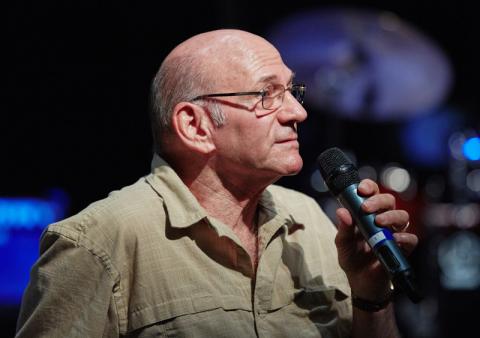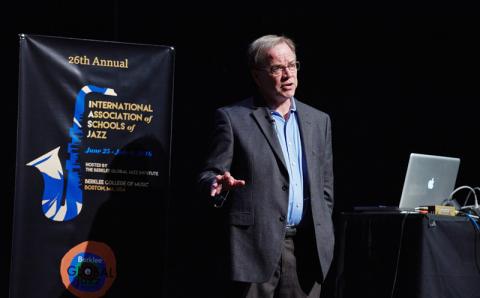Jazz Master Dave Liebman Offers Advice for Young Musicians

Dave Liebman lectures during the weeklong jazz conference.
Dave Green

Allan Chase gives a presentation.
Dave Green
Allan Chase, chair of Berklee’s Ear Training Department, concluded his International Association of Schools of Jazz (IASJ) lecture on the “First Voyagers” into outside writing and improvising with what amounted to a sigh of relief. “It feels funny giving this lecture in front of Dave Liebman,” Chase confessed. “When I was a student in the late ’70s and most musicians answered my questions by saying `go figure it out yourself,’ Dave was the first to explain exactly what I wanted to know.”
Liebman, the acclaimed saxophonist and National Endowment for the Arts Jazz Master, has only intensified his efforts over the succeeding decades. “No one of Dave’s stature from his generation is as committed to jazz education,” notes his colleague Walter Turkenburg, and that commitment was tangible in the lectures, rehearsals, recording sessions, and performances that comprised the IASJ’s 26th annual meeting, held at Berklee in late June. Liebman is the organization’s founder and artistic director, and with the assistance of his wife, Caris, and daughter Lydia, kept the week’s activities moving forward. We caught up with him in a rare open moment.
What motivated the founding of the IASJ?
I was spending a lot of time in Europe in the ’80s and realized that most musicians in one country didn’t know about any musicians in other countries. Being a neutral observer, I thought that I could navigate the divide, so I called a meeting in Germany in 1989 for jazz educators. Thirteen schools from 10 countries showed up, and we went from there.
What do the students who attend the meetings gain?
They will walk out of here with gigs in other countries, and they’ll also have new friends who might provide them with places to stay. But I always make the point that it’s up to them to follow through.
How do you address the challenges they will face as professionals?
I tell them that it’s a long run, not a short run, and that only one or two each session will make it. But they’ve got to be great, to stick with it...And some of them may have to go to New York, if only to see who’s ahead of them.
I noticed that, in addition to technical information, you share stories about your experiences as a young musician.
I’m from the last generation that didn’t come up through the schools, and that played night after night with the real masters. I was lucky, and I try to transmit it with my stories, which is the way this music is really transmitted.
What is the balance that you’ve struck between performing and teaching?
My calendar is all combined because teaching, like composing, is part of playing. I always emphasize that you have to be able to write, and to play, and to give a clinic.
What are your goals for IASJ?
Since jazz is the perfect vehicle for cross-cultural communication, I’m looking to create the United Nations of Jazz. I’m going to Shanghai in October, and I’ll be selling IASJ when I get there. We have members from over 40 countries now. When we have members from all 193 UN countries, I’ll be done.
